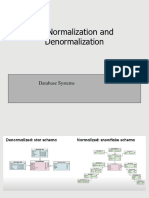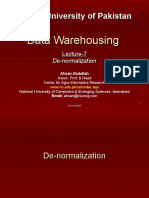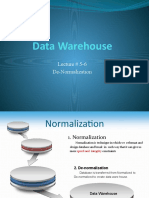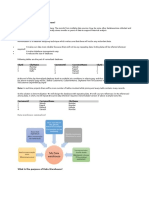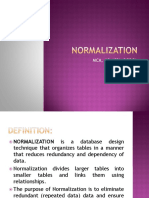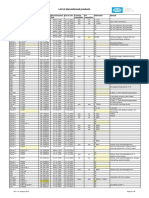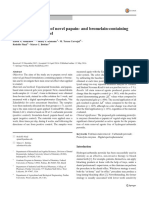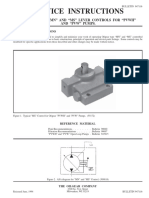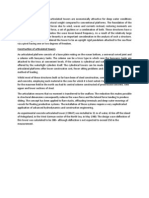ASSIGNMENT-2
(Apex Institute of Technology,
Management)
Subject: Data Base Management System
Subject code: 23BBT-625
Submitted By: Submitted To:
Name: ANANT KUMAR TYAGI Prof. Sakshi
UID: 23MBA20171
Branch/Sec: 23MBM-103
Assignment –2
Denormalization is a database design technique that is employed to improve the
performance of a database system. In a normalized database, data is organized efficiently
to minimize redundancy and dependency. However, there are scenarios where
denormalization becomes a viable option to enhance query performance and simplify
data retrieval.
1. Introduction to Normalization:
Normalization is a process in database design that organizes data in a way that reduces
redundancy and dependency. It involves breaking down tables into smaller, related tables
and establishing relationships between them. The normalization process is beneficial for
data integrity and consistency but may result in increased complexity and slower query
performance, especially in read-heavy scenarios.
2. Understanding Denormalization:
Denormalization is the opposite of normalization. It involves reintroducing redundancy
into a database by adding redundant data or by grouping data that was previously
separated. The primary goal of denormalization is to improve the speed of query
execution and simplify data retrieval. By reducing the number of joins required in a query,
denormalization can lead to faster response times.
3. Scenarios for Denormalization:
There are specific scenarios where denormalization is particularly useful:
Read-Heavy Workloads: In systems where the majority of operations involve reading data
rather than writing, denormalization can be employed to optimize query performance.
Aggregation and Reporting: When dealing with data aggregation or reporting tasks,
denormalization can be beneficial to minimize the need for complex joins and
aggregations.
Real-time Applications: In situations where real-time data access is crucial,
denormalization can reduce the computational overhead associated with joins, providing
faster access to information.
4. Strategies for Denormalization:
Several strategies can be employed for denormalization:
Materialized Views: Creating materialized views that store the results of complex queries
can speed up data retrieval by avoiding the need to recalculate the results each time.
Redundant Data Storage: Introducing redundant data by duplicating information across
tables can eliminate the need for joins, making queries simpler and faster.
Caching: Implementing caching mechanisms can store frequently accessed query results,
reducing the need to execute the same queries repeatedly.
5. Challenges and Trade-offs:
While denormalization offers performance benefits, it comes with its set of challenges
and trade-offs:
Data Redundancy: Introducing redundant data can lead to potential inconsistencies if not
managed properly.
Increased Storage Requirements: Denormalization can result in increased storage
requirements as data is duplicated across tables.
Complex Maintenance: With redundant data, maintaining data consistency becomes
more complex, requiring careful attention during updates and deletions.
Application Code Changes: Denormalization may require changes to application code to
accommodate the new data structure.
In conclusion, denormalization is a valuable technique in database design when optimized
query performance is a priority. However, it should be approached with caution,
considering the specific requirements of the application and the trade-offs involved in
sacrificing some aspects of normalization for improved read performance.
6. Types of Denormalization:
There are different types of denormalization, each with its own advantages and use cases:
Flattening: Involves reducing the number of tables by combining them into a single table.
This simplifies queries but may introduce redundancy.
Vertical Denormalization: In this approach, data from related tables is combined into a
single table, reducing the need for joins. This is particularly useful when dealing with
queries that require data from multiple tables.
Horizontal Denormalization: Involves splitting data into multiple tables based on certain
criteria, such as date ranges. This can enhance performance for queries involving a subset
of the data.
7. Implementation Considerations:
Data Access Patterns: Understanding how data is accessed is crucial. Denormalization is
most effective in scenarios where specific queries or reporting patterns dominate the
application's use.
Update Frequency: If the data undergoes frequent updates, denormalization can
introduce challenges related to maintaining consistency across redundant copies of the
data.
Data Distribution: In distributed database systems, denormalization can affect data
distribution strategies, impacting overall system performance.
8. Tools and Technologies:
Various tools and technologies support denormalization, including:
Database Management System (DBMS) Features: Some modern DBMSs offer features like
materialized views, indexing enhancements, and caching mechanisms to facilitate
denormalization.
Caching Solutions: Implementing caching solutions like Redis or Memcached can improve
performance by storing frequently accessed query results.
9. Case Studies:
Examining real-world case studies where denormalization has been successfully
implemented can provide insights into the benefits and challenges. These case studies can
encompass different industries and use cases, such as e-commerce, finance, or
healthcare.
10. Best Practices:
To maximize the benefits of denormalization, consider the following best practices:
Careful Redundancy Management: Establish clear rules for managing redundant data to
avoid inconsistencies.
Regular Performance Monitoring: Monitor the performance of the database system
regularly to identify and address any performance degradation.
Documentation: Document the denormalization strategy and rationale thoroughly to
facilitate future maintenance and modifications.
Testing and Benchmarking: Before implementing denormalization in a production
environment, thoroughly test and benchmark the changes to ensure they deliver the
expected performance improvements.








